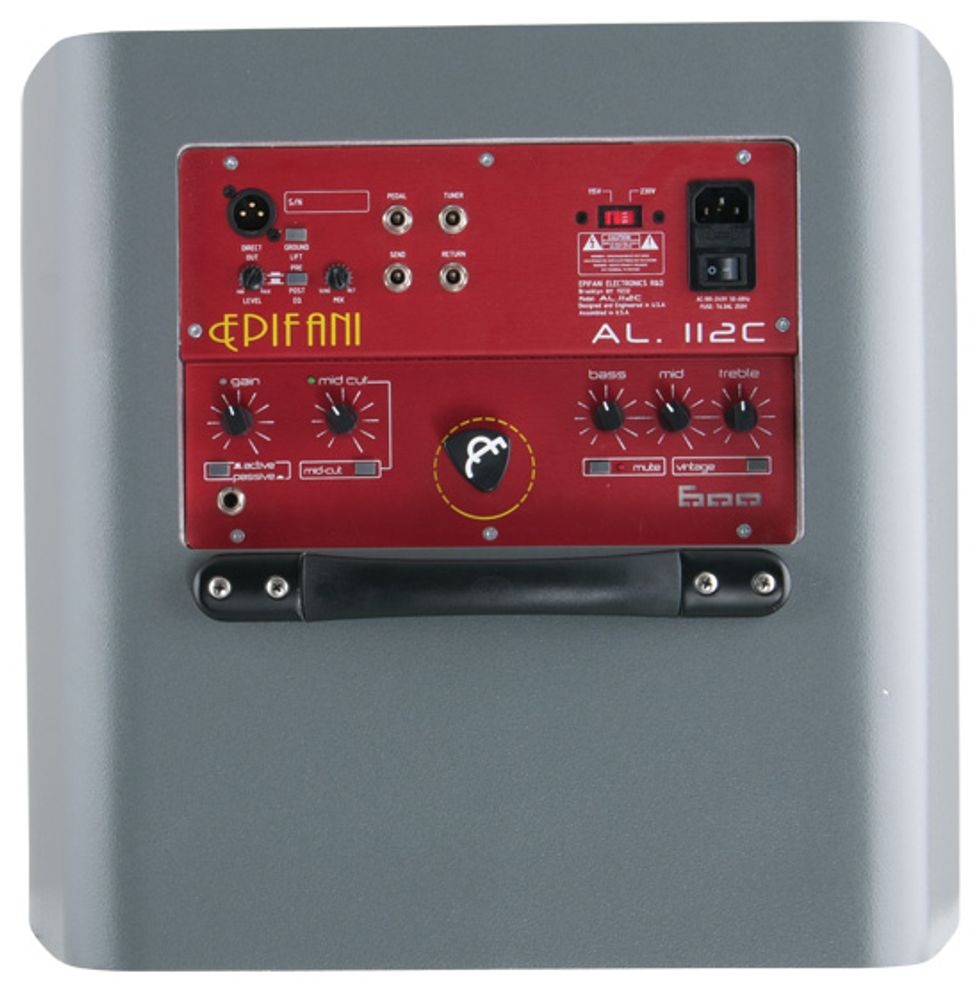Respected bass-amplification guru Nick Epifani knows a thing or two about cabinet design. After much research and development alongside industrial designer and longtime Epifani team member Romano Ferretti, Epifani has released the AL series of combos and extension cabinets. Encasing Epifani’s signature drivers in lightweight, solid-aluminum shells that follow the Italian design tradition of form equaling function, these new cabs and combos represent the first of their kind. Our introduction to the AL series came in the form of the AL 112—a futuristic-looking combo that’s capable of delivering a ton of tone.
AL-chemy
The front-ported AL 112 is a unique
hybrid of Epifani’s past and present innovations.
The aluminum shell has a distinctive
trapezoidal design with slightly bowed
sides. According to Epifani, this shape
delivers improved frequency response and
an overall stronger output, while the aluminum’s
rigidity yields a protective shell
with less weight.
Inside the AL 112 is another breakthrough in bass amplification that Epifani introduced four years ago—a 12" dual-voice-coil ceramic speaker that uses the company’s dual-impedance speaker technology (D.I.S.T.). With the flick of a rear-mounted switch, the D.I.S.T. converts the driver to either 4 ??Ω or 8 Ω? operation. This allows the option to run single or multiple speakers, while optimizing the delivery of power to the driver(s).
The same 600-watt amplifier from Epifani’s Piccolo 600 drives the AL 112. Its control panel provides simplicity and flexibility that surpasses many in its class. The tone controls consist of three shelving knobs—bass, mid, and treble. A vintage switch subdues the upper mids and highs to create a round, old-school sound, while mid cut can temper the honk of an upright pickup or be a slapper’s delight by scooping up to -8 dB at 800 Hz. Throw in an effects loop, DI, and a mute switch, and you have Epifani’s recipe for maximum tone production with minimum components.
Prima Impressione
At just a hair under 40 pounds, the AL 112
weighs less than your standard 12" ceramic-driver
cabinet, but this combo doesn’t
necessarily feel like a featherweight. One
possible reason might be the placement of
the handle, which makes for an unbalanced,
awkward lift. Further, the hard plastic
handle did not elicit complete confidence as
it rattled back and forth in transport, and it
took a while for me to eventually trust that
it wouldn’t break.
However, all this was quickly forgotten when I powered up the amp and played it with a 1964 Fender Jazz, a 1966 Fender Jazz with flatwounds, a Nash P-style, and an Ibanez BTB 6-string. Regardless of dynamic level, the AL 112 delivered each bass’ tones with a thick fundamental and a clean top end. Jaco disciples would love how both Jazz basses’ bridge pickups performed through the Epifani. With a touch of mid boost, each note fired out of the cab with immediacy and a slightly compressed feel that made harmonics pop. The AL 112 wasn’t afraid of any B-string bombs either, dropping notes from the first five frets with a chest-punching attack. The low end of the Nash P-style was massive, and engaging the combo’s vintage mode brought that buh sound into Motown-like bass lines.
The Little Combo That Could
I played the AL 112 in a variety of situations,
and each one highlighted its quality.
With a 10-piece horn band and master
volume at 10 o’clock, the Nash rang out
easily over an aggressive drummer and a
bold brass-and-woodwind section. They
even asked me to turn down so the vocalists
could hear themselves.
Ratings
Pros:
Mind-bogglingly responsive and powerful. Sounds
great in almost every setting. A best-in-class bass rig.
Cons:
Cabinet and handle design can make for
awkward transport.
Tones:
Playability/Ease of Use:
Build/Design:
Value:
Street:
$1,599
Company
epifani.com
The pinnacle of my AL 112 pleasure came on a funk gig when I placed the rig between two 100-watt half stacks and a notoriously loud drummer. The vocalist, who was responsible for the P.A., ran a line from the Epifani’s direct out to the board, and the AL 112’s master volume was set around noon. As we began to play, the notes from the ’66 Jazz came out with excellent presence and definition. Two songs into the set, the vocalist came over and apologized for forgetting to unmute the bass channel in the P.A—all that bass goodness was coming solely from the tiny Epifani. Everybody in the band was stunned.
I had similar successes at gigs playing blues, salsa, and rock covers. It didn’t matter which bass I played—the rig was unflappable and preserved its sonic space with plenty of clarity and volume. The fact that this diminutive combo could hang on gigs where I’d normally use an 800-watt amp and a 4x10 cabinet says volumes (pun kind of intended) about the AL 112’s design. But the best part came at the end of each night, when I could tear down and have the car packed in less than five minutes.
After so much success with electrics, I decided to throw the AL 112 one last curve ball and plug in my upright bass, which is equipped with a Fishman Full Circle pickup. With a little help from the mid-cut dial, I was able to mellow out the nasty midrange frequencies that have plagued this particular bass when amplified. It didn’t take long at all to sculpt a pleasing tone that brought out the acoustic character of the upright.
The Verdict
So is aluminum a worthy material for a
bass-cab design? After rigorous testing in
different environments, the AL 112 combo
certainly makes a compelling argument.
Epifani has used it to engineer a metallic
masterpiece that delivers the best of what
your bass has to offer in a sturdy, powerful
package. This combo may be the ultimate
one-trip-rig for a working bassist at any
level. It sounded so good, no matter what
I threw at it, that I was able to stop worrying
about my gear and completely focus on
what really matters—making music.










![Rig Rundown: AFI [2025]](https://www.premierguitar.com/media-library/youtube.jpg?id=62064741&width=1245&height=700&quality=70&coordinates=0%2C0%2C0%2C0)












 Shop Scott's Rig
Shop Scott's Rig
![Rig Rundown: Russian Circles’ Mike Sullivan [2025]](https://www.premierguitar.com/media-library/youtube.jpg?id=62303631&width=1245&height=700&quality=70&coordinates=0%2C0%2C0%2C0)














































